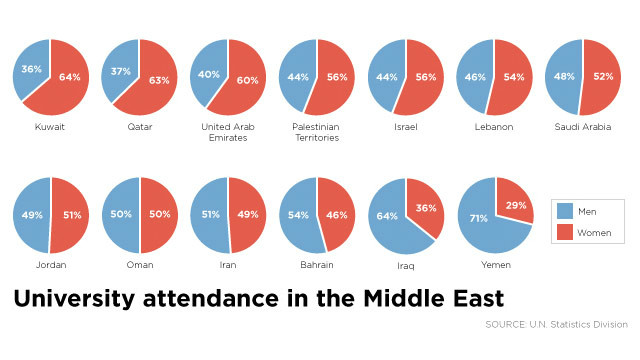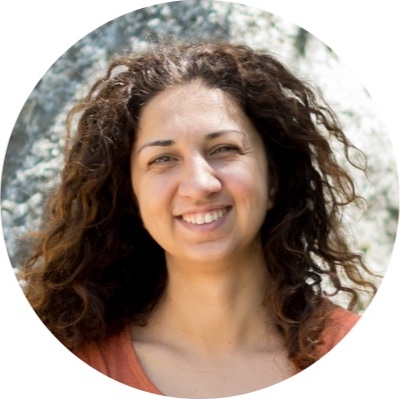![]() English version below / Vai alla versione italiana
English version below / Vai alla versione italiana
This is part 2 of a series of posts on Maryam Mirzakhani’s story. You can find the previous installment here: part 1.
In A Mathematician’s Apology, Hardy wrote, “Oriental mathematics may be an interesting curiosity, but Greek mathematics is the real thing.” Well… not really! The “Oriental” contributions to everyday mathematics are plentiful: numbers, algebra and trigonometry - just to name a few. Diminishing the cultures of the colonized countries was a core part of the colonization process, and Hardy’s book was written in 1940, exactly during the British colonial domination in the Orient. Indeed, as we will explain today, the entire concept of “the Orient” is an invention which dates back to the colonial period.
In his book Orientalism, published in 1978 and now considered a key reference on post-colonial studies, Edward Said analyses how Europeans represented the peoples and societies of the Middle East, North Africa and Asia over two centuries. After Napoleon’s invasion of Egypt in 1798, “The Orient” was represented in arts and literature as a place of fantasy, of exotic wonders, of lust, of sensuality, a place inhabited by the “Other”. Said ponders how the West has used the Orient as an “inverted” mirror in order to oppress its people and manage its resources, that is, to colonise it. To every Western virtue there was a corresponding Oriental vice; the Orient was pictured as everything the West was not: the rational, civil, developed, virtuous, chaste, puritan, “superior” West (‘us’) clashed with the irrational, savage, underdeveloped, immoral, licentious, debauched, “inferior” Orient (‘them’).
This narrative of the Orient linked to Western colonialism spawned flawed beliefs, myths and clichés that are still around today. In Western media it is not uncommon for Middle Eastern women to be stereotypically portrayed in one of three ways. The first one, originating in the Orientalist tradition of 19th century Romanticism, depicts them as symbols of lust and objects of erotic fantasies, easily bent to men’s desires, exotic, sensual, uninhibited, promiscuous (e.g. belly dancers enslaved in harems). The second and third ones, related to the recent islamophobic wave, paint them as dominated by their religion, fully-veiled, sexually oppressed, almost illiterate, submissive housewives, locked up in their houses, or else as potential terrorists, ready to blow themselves up, if commanded to. In each of the three cases, Oriental women are depicted as victims, incapable of self-determination.
The many Western military interventions in the Middle East and North Africa (MENA) in the past century fostered the rise to power of ultra-conservatives and Islamic fundamentalists in many countries, which brought hardship upon millions of women. Yet, there are still huge differences among nations in this area (as well as within countries themselves): the East is not at all a monolithic and culturally homogeneous block, as the 19th century orientalist narrative suggests. In the book Fifty Millions Rising, published last January, Saadia Zahidi, Head of Education, Gender and Work, and a Member of the Executive Committee at the World Economic Forum, discusses the working and financial condition of women in sixteen countries in the Middle East and Northern Africa. Unlike what many westerners believe, in many countries women study more than men (see chart below), particularly in STEM areas, and, in spite of the many problems they faced, more than fifty million women managed to enter the job market in the past decade, sometimes pioneering new technologies.
“I should say that the education system in Iran is not the way people imagine here.” said Maryam Mirzakhani in this interview. “As a graduate student in Harvard, I had to explain quite a few times that I was allowed to attend a university as a woman in Iran”. Indeed, according to Human Rights Watch, at the moment Iranian laws and policies make it very difficult for women to access the job market, but “over the past four decades, Iranian women have become half of the country’s university graduates.” Moreover, according to Quartz, citing Zahidi, in Iran roughly 70% of STEM graduates are women! This is not an isolated case. In Oman, Saudi Arabia and the United Arab Emirates, the share is only marginally lower (60%). “Several Muslim countries” reports Quartz, “have filled more than half of STEM jobs with female workers.” The exceptional nature of the MENA area with respect to the STEM gender gap has long been known to experts (see these articles, for example). UNESCO’s report Cracking the Code actually shows a “reversed” gender gap: in many MENA countries, girls generally outperform boys in math and science tests.
Even though many of these countries score poorly according to the World Economic Forum Gender Gap Index, the relationship between MENA women and science appears to some extent healthier than it is in many Western countries. In our opinion, this is yet another piece of evidence showing that “math, science and tech are male subjects” is nothing but a cliché, probably Western-made, and there are no such things as a “superior West” and an “inferior East”.
TO BE CONTINUED in part 3.
![]() Versione italiana a seguire / Back to English
Versione italiana a seguire / Back to English
Questa è la seconda parte della serie di post sulla storia di Maryam Mirzakhani. Il post precedente è qui: parte 1.
In Apologia di un matematico Hardy scrive “La matematica orientale può sembrare una curiosità interessante, ma è la matematica greca quella che conta davvero”. Beh… in realtà le cose non sono andate proprio così! I contributi “orientali” alla matematica della nostra vita quotidiana sono innumerevoli: i numeri, l’algebra e la trigonometria - solo per citarne alcuni. Sminuire le culture dei paesi colonizzati fa parte del processo di colonizzazione, e il libro di Hardy è stato scritto nel 1940, proprio durante il periodo di dominazione coloniale britannica in Oriente. In realtà, come vedremo oggi, anche il concetto di “Oriente” come blocco culturalmente omogeneo è un’invenzione che risale al periodo coloniale.
Nel saggio Orientalismo, pubblicato nel 1978 e oggi considerato una pietra miliare negli studi post-coloniali, Edward Said analizza il modo in cui gli europei hanno rappresentato le società e i popoli che abitano nel Medio Oriente, nel Nord Africa e in Asia negli ultimi due secoli. Dopo l'invasione napoleonica dell'Egitto (1798) in Europa si sviluppò un movimento artistico e letterario che inventava “l’Oriente”, rappresentandolo come il luogo dell'immaginazione, delle meraviglie esotiche, del piacere, della sensualità, il luogo in cui abita l’“Altro”. Said riflette su come l'Occidente abbia usato l'Oriente come specchio “invertito” allo scopo di sottometterne le popolazioni e gestirne le risorse, cioè colonizzarlo. Ad ogni alta virtù “occidentale” corrispondeva un basso vizio “orientale”; l'Oriente veniva immaginato come tutto quello che l'Occidente non era: ad un Occidente razionale, civile, sviluppato, virtuoso, casto, puritano, “superiore” (‘noi’) si contrapponeva un Oriente irrazionale, selvaggio, sottosviluppato, immorale, lussurioso, depravato, “inferiore” (‘loro’).
La narrazione dell'Oriente legata al colonialismo occidentale ha generato false credenze, miti e luoghi comuni che persistono ancora ai giorni nostri. Nei media occidentali non è raro vedere le donne mediorientali rappresentate stereotipicamente in tre modi. Il primo, mutuato dalla tradizione orientalista del Romanticismo Ottocentesco, le vede simboli di lussuria e oggetto di fantasie erotiche, facilmente accondiscendenti ai desideri maschili, sensuali, esotiche, disinibite, promiscue (ad esempio, le danzatrici del ventre schiave negli harem). Il secondo e il terzo, legati alla recente ondata di islamofobia, le dipinge come schiave della loro religione, interamente velate, sessualmente oppresse, analfabete o quasi, casalinghe rinchiuse in casa oppure come potenziali terroriste, pronte a farsi saltare in aria a comando. In tutti e tre i casi, le donne orientali vengono presentate come vittime incapaci di autodeterminarsi.
I numerosi interventi militari occidentali in Medio Oriente e del Nord Africa (MENA) nel secolo scorso hanno favorito l'ascesa al potere di gruppi ultra-conservatori e fondamentalisti islamici in molti paesi e ciò sta creando condizioni difficili per milioni di donne. Sussistono, però, differenze enormi fra i vari paesi dell'area (nonché all'interno dei paesi stessi): l'Oriente non è affatto un blocco monolitico e culturalmente omogeneo, come invece la narrativa orientalista ottocentesca ci ha fatto credere. Nel libro Fifty Millions Raising, pubblicato a gennaio 2018, la responsabile di Genere, Istruzione e Lavoro al World Economic Forum, Saadia Zahidi analizza la condizione economica e lavorativa delle donne in sedici paesi nel Medio Oriente e in Nord Africa. A differenza di quanto molti occidentali pensano, in molti paesi le donne studiano più degli uomini, in particolare nelle discipline STEM (si veda il grafico qui sotto). Malgrado i molti problemi affrontati, oltre cinquanta milioni di donne sono riuscite a inserirsi nel mercato del lavoro nell'ultimo decennio, in alcuni casi diventando pioniere della tecnologia.
“Dovrei dire che il sistema di istruzione in Iran non è quello che la gente immagina qui.”, dice Maryam Mirzakhani in questa intervista, “da dottoranda ad Harvard, ho dovuto spiegare un bel po’ di volte che, in quanto donna, potevo frequentare l’università in Iran.” Infatti, secondo Human Rights Watch, al momento le leggi iraniane rendono difficoltoso l’accesso delle donne al mercato del lavoro, ma, “negli ultimi quarant’anni, le donne iraniane sono diventate più della metà dei laureati del paese”. Inoltre riporta Quartz citando Zahidi, in Iran circa il 70% dei laureati STEM sono donne! Non si tratta di un caso isolato: in Oman, Arabia Saudita e Emirati Arabi Uniti la percentuale è di poco inferiore (60%). “In alcuni dei paesi dell'area”, continua Quartz, “le donne formano oltre metà della forza-lavoro STEM.” L'eccezionalità dell'area MENA nel gender gap nelle professioni STEM era già nota da tempo agli esperti (per esempio si vedano questi articoli. Lo studio UNESCO Cracking the Code segnala addirittura un gender gap in senso inverso: in molti paesi del MENA le ragazze sono, in generale, più brave dei ragazzi in tutti i test di matematica e scienze.
Malgrado molti di questi paesi ottengano punteggi bassi secondo il World Economic Forum Gender Gap Index, il rapporto fra donne del MENA e scienza appare per alcuni aspetti più sano di quanto non lo sia in molti paesi occidentali. A nostro avviso ciò non è che una riprova del fatto che “matematica, scienza e tecnologia sono discipline maschili” è un luogo comune (probabilmente di fattura occidentale) e che non esistono un “Occidente civilizzato/superiore” e “Oriente barbaro/inferiore”.
CONTINUA con il terzo episodio.




 Valentina is a Postdoc in Geometric Topology at Heidelberg Universität in Germany. Having grown up in a small town in Salento, she got interested in maths as a teenager thanks to the Italian Maths Olympiad and a noisy 56k modem. After being a contestant in the Italian Finals in Cesenatico, she started solving the beautiful problems posted on the OliForum and its mailing list. She has lived abroad since 2010, and has worked in France and the US, where she also attended many events and panels discussing the gender gap in STEM fields. When she is not doing maths, she enjoys reading good literature, traveling, volunteering and dancing rueda de casino.
Valentina is a Postdoc in Geometric Topology at Heidelberg Universität in Germany. Having grown up in a small town in Salento, she got interested in maths as a teenager thanks to the Italian Maths Olympiad and a noisy 56k modem. After being a contestant in the Italian Finals in Cesenatico, she started solving the beautiful problems posted on the OliForum and its mailing list. She has lived abroad since 2010, and has worked in France and the US, where she also attended many events and panels discussing the gender gap in STEM fields. When she is not doing maths, she enjoys reading good literature, traveling, volunteering and dancing rueda de casino.